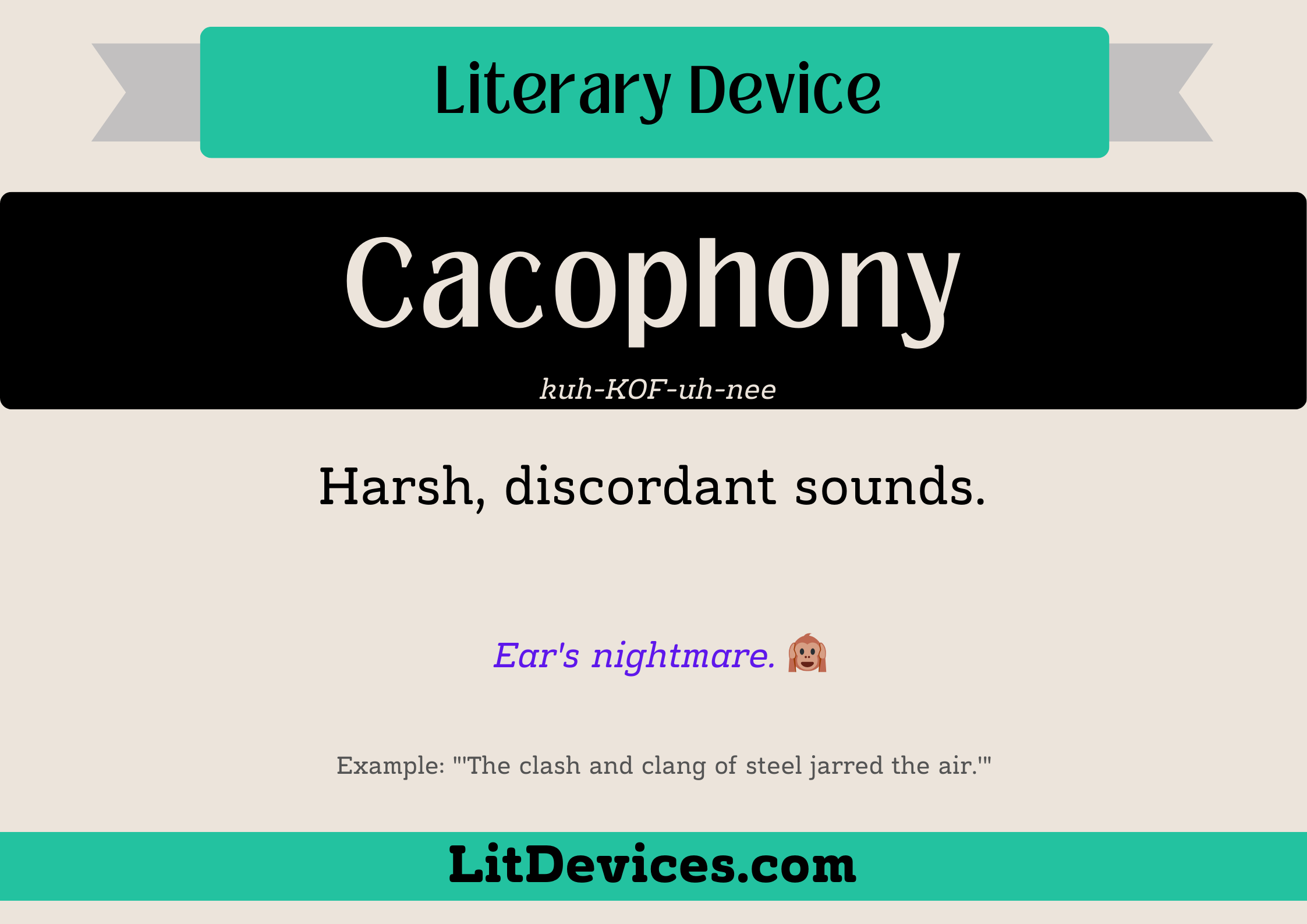What is Cacophony?
Opposite of euphony, cacophony creates harsh, discordant sounds, typically through the repetition of consonants. It is often used to create a sense of chaos or confusion by using hard consonants or words with multiple syllables. Cacophony often employs the repetitive uses of what has been referred to as “explosive” or “stop” consonants such as, B, D, G, K, P, S, and T. When a writer uses cacophony, the sounds may or not match up with the content or specific piece of literature. Rather, cacophony considers how the sounds pertain to the context of the piece. Example: “Howl,” by Allen Ginsberg.
How to pronounce Cacophony?
Why do Writers Use Cacophony?
Writers use cacophony:
- As an appeal to the readers’ senses. They want the reader to be able to picture and feel the scene or situation they are describing.
- To amplify or intensify the harsh or uncomfortable scenario they are describing.
- To express energy or mood.
- To create a sense of tension or evoke a feeling of dread.
While cacophony relies on the use of harsh sounds, the effect is often musical and adds an element of beauty to the text.
Cacophony in Literature and Poetry 📚
“Howl,” by Allen Ginsberg –
“What sphinx of cement and aluminum bashed open their skulls and ate up their brains and imagination?
Moloch! Solitude! Filth! Ugliness! Ashcans and unobtainable dollars! Children screaming under the stairways! Boys sobbing in armies! Old men weeping in the parks!
Moloch! Moloch! Nightmare of Moloch! Moloch the loveless! Mental Moloch! Moloch the heavy judger of men!”
“The Tyger,”by William Blake –
“Tyger! Tyger! burning bright
In the forests of the night”
“Daddy,” by Sylvia Plath –
“There’s a stake in your fat black heart
And the villagers never liked you.
They are dancing and stamping on you.
They always knew it was you.
Daddy, daddy, you bastard, I’m through.”
“The Raven,” by Edgar Allen Poe –
“Fancy unto fancy, thinking what this ominous bird of yore—
What this grim, ungainly, ghastly, gaunt, and ominous bird of yore
Meant in croaking, ‘Nevermore.’”
And in children’s literature, Lewis Carrol, “Jabberwocky” –
“Twas brillig, and the slithy toves
Did gyre and gimble in the wabe:
All mimsy were the borogoves,
And the momeraths outgrabe.
“Beware the Jabberwock, my son!
The jaws that bite, the claws that catch!
Beware the Jubjub bird, and shun
The frumious Bandersnatch!”
And listen to Benedict Cumberbatch read the poem:
Cacophony related literary devices 🧸
- Euphony – The opposite of cacophony. Euphony uses specific words and sounds to add a musical, harmonic effect to text.
- Dissonance – The term most closely related to cacophony. Dissonance refers to a general lack of harmony among words and phrases but is more commonly associated with the sound of music. While cacophony may appear to create chaos and dissonance, unlike dissonance, cacophony can add a musical effect to text.
- Consonance – The repetition of the same sounds or consonants in a line of text, Example: pitter, patter. While on the surface, consonance may appear to be similar or the same as cacophony, the two are very different. Cacophony’s purpose is to add loudness, noisiness, or harshness to text, but that is not always the purpose of consonance.
Cacophony in Music 🎧
While a little more difficult to identify in modern song and music, a trip to the past will turn up a bevy of classical examples of cacophony in music. However, one clearly stands above all others:
Beethoven’s Fifth Symphony
What is cacophony in literature?
Cacophony refers to the use of harsh, discordant sounds in a line or passage of text to create a jarring and uncomfortable effect. This literary device is employed to convey disorder, tension, or to evoke a particular emotional response from the reader, often through the deliberate use of hard consonants and sounds that are difficult to pronounce.
How does cacophony enhance a text?
Cacophony enhances a text by adding a layer of auditory imagery that can intensify the atmosphere or mood. It can make the reading experience more visceral or disturbing, effectively drawing the reader’s attention to particular themes or emotions the author wishes to emphasize.
Can cacophony be found in both poetry and prose?
Why do writers use cacophony?
Writers use cacophony to express dissonance, chaos, or to highlight a sense of conflict or unease within their text. It serves as a powerful tool to affect the reader’s perception and emotions, making the experience of reading more dynamic and engaging by engaging the auditory senses.
How can I identify cacophony in a text?
To identify cacophony, look for passages where the language feels harsh, jarring, or awkward to read aloud. This is often achieved through the use of consonant-heavy words, awkward combinations of sounds, or a prevalence of harsh-sounding letters like ‘k’, ‘t’, ‘g’, ‘d’, and ‘p’. These sounds, when used together, can create a sense of discord and tension that stands out from the surrounding text.

